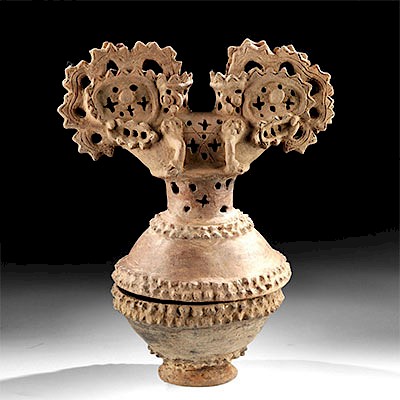Chavin Lapis or Sodalite Pectoral
Lot 78
About Seller
Artemis Gallery
686 S Taylor Ave, Ste 106
Louisville, CO 80027
United States
Selling antiquities, ancient and ethnographic art online since 1993, Artemis Gallery specializes in Classical Antiquities (Egyptian, Greek, Roman, Near Eastern), Asian, Pre-Columbian, African / Tribal / Oceanographic art. Our extensive inventory includes pottery, stone, metal, wood, glass and textil...Read more
Categories
Estimate:
$3,000 - $6,000
Absentee vs Live bid
Two ways to bid:
- Leave a max absentee bid and the platform will bid on your behalf up to your maximum bid during the live auction.
- Bid live during the auction and your bids will be submitted real-time to the auctioneer.
Bid Increments
| Price | Bid Increment |
|---|---|
| $0 | $25 |
| $300 | $50 |
| $1,000 | $100 |
| $2,000 | $250 |
| $5,000 | $500 |
| $10,000 | $1,000 |
| $20,000 | $2,500 |
| $50,000 | $5,000 |
| $100,000 | $10,000 |
| $200,000 | $20,000 |
About Auction
By Artemis Gallery
Aug 22, 2019
Set Reminder
2019-08-22 10:00:00
2019-08-22 10:00:00
America/New_York
Bidsquare
Bidsquare : Fine Ancient | Asian | Ethnographic Art
https://www.bidsquare.com/auctions/artemis-gallery/fine-ancient-asian-ethnographic-art-4348
Featuring classical antiquities, ancient and ethnographic art from cultures encompassing the globe, plus fine art. Egyptian, Greek, Roman, Etruscan, Near Eastern, Asian, Pre-Columbian, Native American, African / Tribal, Oceanic, Spanish Colonial, Russian, Fine Art, so much more! Artemis Gallery info@artemisgallery.com
Featuring classical antiquities, ancient and ethnographic art from cultures encompassing the globe, plus fine art. Egyptian, Greek, Roman, Etruscan, Near Eastern, Asian, Pre-Columbian, Native American, African / Tribal, Oceanic, Spanish Colonial, Russian, Fine Art, so much more! Artemis Gallery info@artemisgallery.com
- Lot Description
Pre-Columbian, Peru, Chavin, ca. 1200 to 500 BCE. A grand necklace with beads carved from lapis lazuli or sodalite (one of the primary elements of lapis lazuli) mined from the Andes and cherished since antiquity. The piece is comprised of eleven, large shell-shaped beads of rich blue-violet hues and cream-colored veining. Each bead was skillfully incised with vertical lines that were rubbed with red cinnabar, resulting in a dramatic color contrast. An impressive pectoral, replete with the finest workmanship and beads made from inherently beautiful lapis lazuli or sodalite. Size: necklace measures 15" L (38.1 cm); 11" W x 10" H (27.9 cm x 25.4 cm) on custom stand; largest bead (at center) 2.25" L x 1.75" W (5.7 cm x 4.4 cm)
An impressive and large pectoral that shows the finest workmanship and is comprised of ancient beads carved from superb stone. Lapis lazuli and sodalite were coveted materials, ideal for embellishing an elite individual's possessions and fostering his/her passage to the afterlife. Sodalite is also known as Poet's Stone, and according to legend, sodalite promotes both creativity and mental lucidity.
The Chavin civilization developed in the northern Andean highlands of Peru from 900 to 200 BCE in the Mosna Valley where the Huachecsa and Mosna rivers merge. The most famous archaeological ruin of the Chavin culture is Chavin de Huantar. Believed to have been built around 900 BCE, this religious center is now a UNESCO world heritage site.
Provenance: private Hawaii, USA collection; ex-Bettina Schwimmer collection, Chicago, Illinois, USA
All items legal to buy/sell under U.S. Statute covering cultural patrimony Code 2600, CHAPTER 14, and are guaranteed to be as described or your money back.
A Certificate of Authenticity will accompany all winning bids.
We ship worldwide and handle all shipping in-house for your convenience.
#148459All beads are ancient. Modern stringing and findings. A few of the beads have minute, nearly invisible nicks to peripheries, and minor surface wear/abrasions. Nice traces of red cinnabar remain in recesses.Condition
- Shipping Info
-
All shipping is handled in-house for your convenience. Your invoice from Artemis Gallery will include shipping calculation instructions. If in doubt, please inquire BEFORE bidding for estimated shipping costs for individual items.
-
- Buyer's Premium



 EUR
EUR CAD
CAD AUD
AUD GBP
GBP MXN
MXN HKD
HKD CNY
CNY MYR
MYR SEK
SEK SGD
SGD CHF
CHF THB
THB














